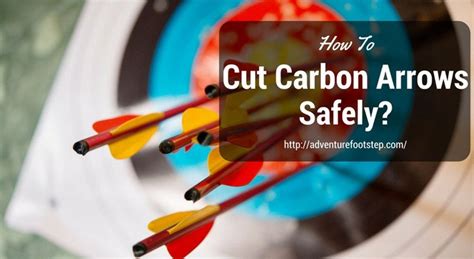Avoid Common Mistakes: Cutting Carbon Arrows Properly
Carbon arrows have revolutionized archery, offering superior performance and durability compared to aluminum or wood. However, their construction necessitates a precise and careful approach when cutting them to the desired length. Improper cutting can lead to damaged arrows, inconsistent performance, and even injury. This guide will walk you through the process, highlighting common mistakes to avoid.
Why Proper Cutting is Crucial
Cutting carbon arrows incorrectly can compromise their structural integrity. The carbon fiber layers are meticulously arranged to provide strength and stiffness. A poorly executed cut can weaken these layers, leading to:
- Broken arrows: This is the most significant risk. A weakened shaft is more prone to snapping under stress, especially during high-poundage shots or impacts with hard targets.
- Inconsistent flight: Even slight imperfections can affect arrow flight, leading to inaccurate shots and frustrating inconsistencies.
- Damaged fletching: The fletching (arrow feathers or vanes) needs a perfectly square and smooth surface to adhere properly. A rough cut can hinder this, leading to premature fletching failure.
Common Mistakes to Avoid When Cutting Carbon Arrows
Here are some of the most prevalent errors archers make when cutting carbon arrows:
1. Using the Wrong Cutting Tool
Mistake: Using a hacksaw, hand saw, or other tools not specifically designed for cutting carbon fiber. These tools can crush or fray the carbon fibers, compromising the shaft's integrity.
Solution: Invest in a high-quality arrow cutting tool. These specialized tools, often featuring a carbide or diamond-tipped blade, produce a clean, precise cut without damaging the carbon fibers. Many arrow cutting jigs are also available which help to create perfectly perpendicular cuts.
2. Not Using a Cutting Jig
Mistake: Cutting freehand without a jig. This almost always results in an uneven or angled cut.
Solution: A cutting jig provides a stable, perpendicular surface for the cutting tool. This ensures that your cut is perfectly straight and avoids damaging the shaft. Clamp the arrow securely into the jig to prevent movement during the cutting process.
3. Applying Excessive Pressure
Mistake: Forcing the cutting tool through the shaft. This can generate heat and cause damage to the carbon fibers.
Solution: Apply steady, even pressure. Let the sharp blade do the work. Avoid rushing the process; a slow, controlled cut is far superior to a quick, forceful one.
4. Ignoring the Finishing Process
Mistake: Leaving the cut end rough or unfinished. This can lead to damaged fletching or inconsistent arrow flight.
Solution: After cutting, use fine-grit sandpaper to smooth the cut end. This removes any burrs or irregularities and creates a smooth surface for the adhesive used to attach the fletching.
Deburring and Finishing: The Crucial Final Steps
After cutting, carefully deburr the cut end of the arrow shaft using fine grit sandpaper (e.g., 320-grit or higher). This will remove any microscopic imperfections that can cause future issues. A smooth, even end is crucial for consistent arrow flight and proper fletching adhesion.
What Happens if I Make a Mistake?
If you accidentally damage an arrow shaft during the cutting process, it is best to discard it. Using a compromised arrow shaft can result in an inaccurate shot, damaged equipment, or, worse, injury. The cost of a new arrow is much less than the potential cost of a damaged bow or injury.
Choosing the Right Tools and Techniques: A Summary
Selecting the correct tools and techniques for cutting carbon arrows is crucial for ensuring accuracy and the longevity of your arrows. Always invest in a quality arrow cutting tool and jig. Practice on a spare arrow before cutting your expensive competition arrows. A clean, straight cut, followed by proper deburring, will significantly enhance the performance and lifespan of your arrows. Remember that safety and accuracy should always be your top priorities.

